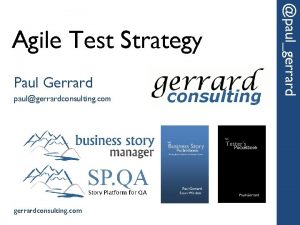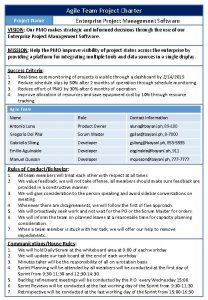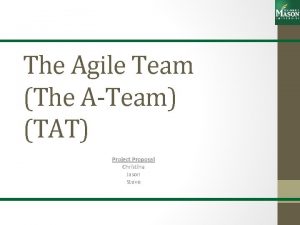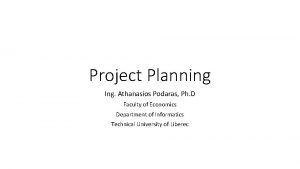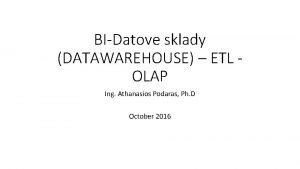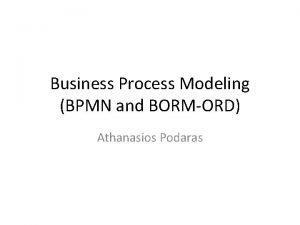Agile Project Management Athanasios Podaras 2015 2016 Traditional










- Slides: 10

Agile Project Management Athanasios Podaras 2015 -2016

Traditional PM versus Agile Methods Traditional PM Approach Concentrates on thorough, upfront planning of the entire project. Requires a high degree of predictability to be effective. Agile Project Management (Agile PM) Relies on incremental, iterative development cycles to complete less-predictable projects. Is ideal for exploratory projects in which requirements need to be discovered and new technology tested. Focuses on active collaboration between the project team and customer representatives.

Traditional Project Management versus Agile Project Management Traditional Agile Design up front Continuous design Fixed scope Flexible Deliverables Features/requirements Freeze design as early as possible Freeze design as late as possible Low uncertainty High uncertainty Avoid change Embrace change Low customer interaction High customer interaction Conventional project teams Self-organized project teams 17– 3 TABLE 17. 1

Agile Project Management Agile PM Is related to the rolling wave planning and scheduling project methodology. Uses iterations (“time boxes”) to develop a workable product that satisfies the customer and other key stakeholders. Stakeholders and customers review progress and re-evaluate priorities to ensure alignment with customer needs and company goals. Adjustments are made and a different iterative cycle begins that subsumes the work of the previous iterations and adds new capabilities to the evolving product. 17– 4

Iterative, Incremental Product Development

Agile Project Management (cont’d) Advantages of Agile PM: Useful in developing critical breakthrough technology or defining essential features Continuous integration, verification, and validation of the evolving product. Frequent demonstration of progress to increase the likelihood that the end product will satisfy customer needs. Early detection of defects and problems. 17– 6

Agile PM Principles Focus on customer value Iterative and incremental delivery Experimentation and adaptation Self-organization Continuous improvement 17– 7

Popular Agile PM Methods Scrum Crystal Clear Extreme Programming RUP (Rational Unified Process) Agile Modeling Rapid Product Development (PRD) Agile PM Methods Dynamic Systems Development Method (DSDM) Lean Development 17– 8

Applying Agile to Large Projects Scaling Is using several teams to work on different features of a large scale project at the same time. Staging Requires significant up-front planning to manage the interdependences of different features to be developed. Involves developing protocols and defining roles to coordinate efforts and assure compatibility and harmony. 17– 9

Limitations and Concerns of Agile PM It does not satisfy top management’s need for budget, scope, and schedule control. Its principles of self-organization and close collaboration can be incompatible with corporate cultures. Its methods appear to work best on small projects that require only five-nine dedicated team members to complete the work. It requires active customer involvement and cooperation. 17– 10
 Introduction to software project management
Introduction to software project management Microsoft project agile template
Microsoft project agile template Wikipedia agile project management
Wikipedia agile project management Traditional management vs entrepreneurial management
Traditional management vs entrepreneurial management Agile inception planning
Agile inception planning Brain maricks test quadrants focus on
Brain maricks test quadrants focus on Agile project charter
Agile project charter Canvas de projeto exemplo
Canvas de projeto exemplo Agile project proposal
Agile project proposal Guest2guest
Guest2guest Project compassion 2016
Project compassion 2016





